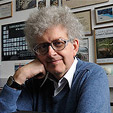Public Lectures
On the occasion of 2010 Asian Science Camp
Fascinating Insights in Chemistry, Biology and Medicine by NMRRichard R. Ernst (Nobel Laureate in Chemistry 1991)
Professor emeritus, Lab fur Phyikalische Chemie
Wolfgang-Pauli-Str, SwitzerlandAbstract
During the past decades, Nuclear Magnetic Resonance (NMR) has developed into a most powerful tool for obtaining revealing insights into the secrets of molecular biology and the funtionof proteins and nucleic acids, and into the human organism for understanding the functioning of organs, for studying the metabolism, for exploring the human brain. and, most important, for diagnosing diseases in clinical medicine. A survey on the possible applications and on the multitude of highly sophisticated techniques will be given.Venue
Phirozshah Mehta Auditorium, University of Mumbai, Kalina Campus, Mumbai - 400098Date and Time
Tuesday, August 17, 2010 at 4:00 PM
Organized by
Homi Bhabha Centre for Science Education, TIFR and
UM-DAE Centre for Excellence in Basic Sciences
About the Speaker
Richard Ernst is Professor Emeritus at the Department of Chemistry and Applied Biosciences, ETH Zurich. Earlier, he was director of the Laboratory of Physical Chemistry at the ETH Zurich Chemistry and led research in magnetic resonance spectroscopy. He received numerous honours, including the Nobel Prize for Chemistry (1991) for his contributions to the development of the methodology of high resolution NMR spectroscopy.
Green Chemistry and Supercritical FluidsMartyn Poliakoff, CBE FRS
School of Chemistry, University of Nottingham
Nottingham, United Kingdom
Abstract
Current research interests involve chemical applications of supercritical fluids, with particular emphasis on Green Chemistry; (MP is currently Chair of the Editorial Board of the RSC journal Green Chemistry www.rsc.org/greenchem. The principal areas of his research are: Supercritical Fluids: New approaches to monitoring Phase behaviour in Supercritical Fluids; Continuous Reactions of Organic compounds in supercritical carbon dioxide including Hydrogenation, Etherification, Acid-catalysed Reactions and Biocatalysis; Reactions in Supercritical Water including selective oxidation of aromatic compounds, formation of metal oxide nanoparticles and vibrational spectroscopy. MP leads the EPSRC/HEFCE Science & Innovation project DICE, Driving Innovation in Chemistry & Engineering, which is promoting research collaboration between chemists and chemical engineers at Nottingham and beyond. http://www.periodicvideos.com/ http://www.nottingham.ac.uk/supercriticalVenue
Venkatraman Auditorium, ICT, (Formerly UDCT), Matunga, Mumbai 400019Date and Time
Wednesday, August 18, 2010 at 4:30 PM
Organized by
Royal Society of Chemistry and
Institute of Chemical Technology, Mumbai
About the Speaker
Sir Martyn Poliakoff, FRS, is Research Professor in Chemistry at the University of Nottingham. He works on gaining insights into fundamental chemistry and developing environmentally acceptable processes and materials. The core themes of his work are supercritical fluids, infrared spectroscopy and lasers. He is well known as the narrator of a 118-part series called The Periodic Table of Videos.
Particle - Antiparticle Symmetry - CP violation and B-factory experimentsMakoto Kobayashi (Nobel Laureate in Physics 2008)
Professor emeritus, High Energy Accelerator Research Organization (KEK), JapanVenue
Prof. V. G. Kulkarni Auditorium, Homi Bhabha Centre for Science Education, TIFR, Mankhurd, Mumbai - 400088Date and Time
Thursday, August 19, 2010 at 2:00 PM
Organized by:
Homi Bhabha Centre for Science Education, TIFR and
UM-DAE Centre for Excellence in Basic Sciences
About Speaker
Makoto Kobayashi was educated on Nagoya University and obtained his Ph.D. in 1972. Along with Toshihide Maskawa, he proposed the so called Kobayashi-Maskawa model in 1973, when they were both in Kyoto University. In 1979, Kobayashi moved to KEK. The B-factory experiments at KEK (High Energy Accelerator Research Organisation) and SLAC have proven that their model describes CP violation of elementary particles correctly. He has been awarded a number of prizes, including the 2008 Nobel Prize in Physics.


